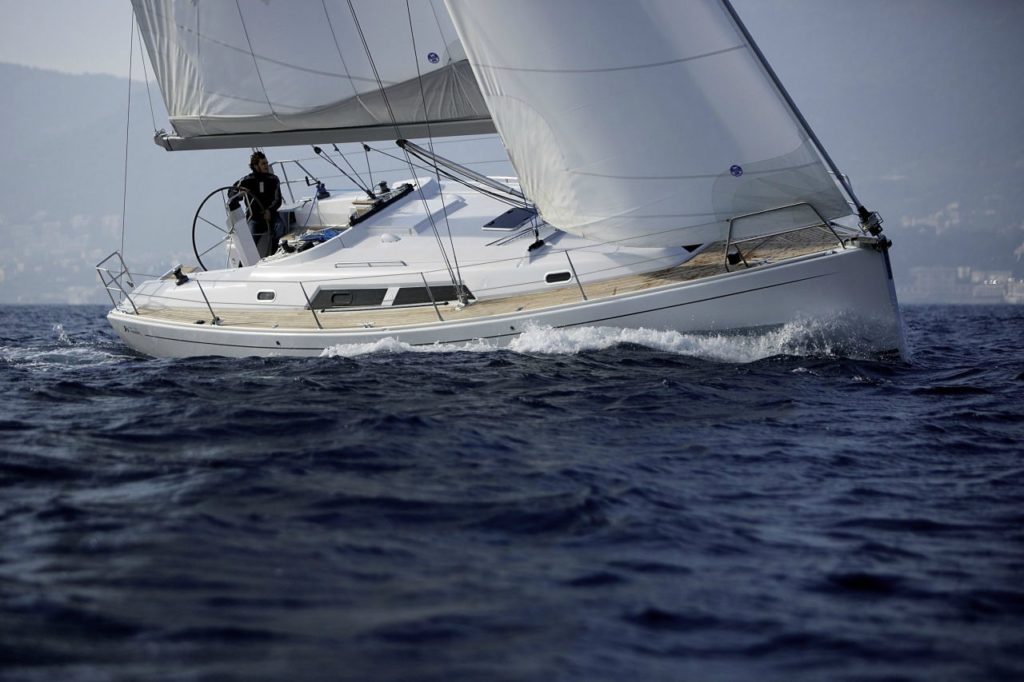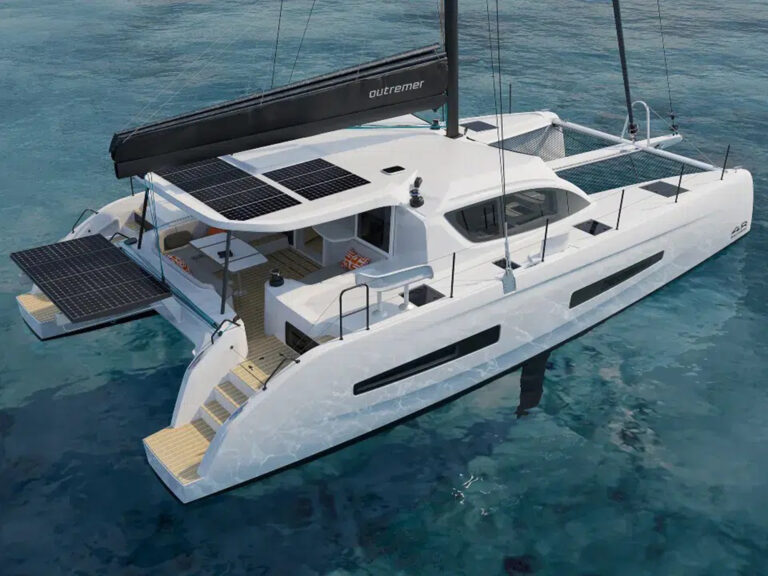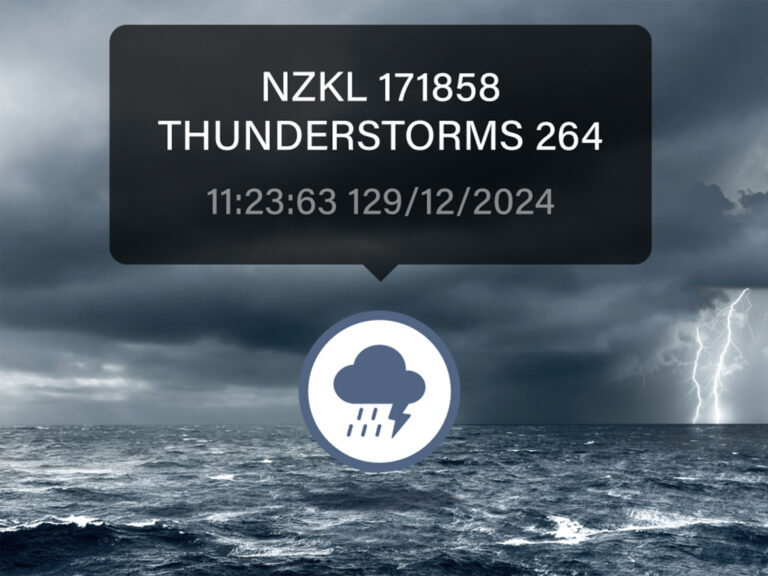
It was a puffy afternoon off Annapolis on the day we took the new Hanse 400e for a test drive, with a teasing northerly breeze of just 6 or 8 knots pulsing down the confines of the Severn River before building to a more respectable 10 to 12 knots a bit southward in the open Chesapeake Bay. In other words, it was just about ideal for gauging a boat’s potential in somewhat light to pleasantly moderate conditions, the sort of weather in which most people actually sail. I’d been hoping for at least a bit of wind because, even dockside, the Hanse is a boat that looks fairly quick and able, and I was eager to see if the long, low profile, combined with its generous double-spreader rig, translated to noteworthy performance under sail.
The 400 is available with many options. There are several cabin layouts, with single or twin double cabins aft, and you can choose from an island-style berth or a beam-width conventional double in the owner’s stateroom forward; regular nonskid or teak decks (though the teak cockpit and seats are standard); twin wheels or a single helm; a deep or a shallow-draft keel, each with a torpedo-shaped bulb; and, in the vessel’s construction, either a traditional fiberglass/foam core layup or a tough, lighter, vacuum-bagged composite/epoxy sandwich (hence the “e” in the name) that saves 900 pounds of displacement.
Our test boat was optimized for the Chesapeake with the shallower keel, the dual helm stations, and the epoxy hull. While I’m sure there are benefits to the other configurations, it was difficult to quibble with the combination at hand. The view forward from either of the wheels is expansive and uncluttered, thanks largely to the streamlined coachroof, the recessed headsail furling drum, and the absence of visible running rigging, which is stashed neatly beneath easily removed deck plates and led aft to twin banks of Spinlock clutches and a pair of Lewmar self-tailing winches to either side of the companionway. (The starboard halyard winch on the test boat was electric.) The Simrad chart plotter is mounted just aft of the centralized cockpit table and, in keeping with the overall theme, is clearly visible.
Under way, the plotter provided a steady record of our speed, and the numbers were impressive. With a full-hoist main and the standard 95-percent self-tacking jib, we scooted along at 5.6 to 6.3 knots in less than 8 knots of true wind while close- and beam-reaching in the confines of the river. Once outside, in 10 to 12 knots true, we managed a solid 6.5 to 6.7 knots while hard on the breeze and watched the figures slide up to the 7-knot range when just slightly cracked off. With the breeze up to 12, we fell off to a beam reach and soared along at about half a knot faster. The helm, throughout the exercise, was light and extremely responsive. Once the sails were stashed-the boat is equipped with an excellent lazy-jack system for corralling the main-we conducted trials under power and saw speeds of 7.5 knots at 2,500 rpm and about 8 knots when ramped up to 3,000 rpm. The boat backed down with authority and without vibration.
Were there things I’d like to change? Well, sure-it’s a boat! I’m not a fan of coachroof-mounted mainsheets-the driver should be able to dump the main if things get squirrelly, but Hanse is hardly the lone offender in this. Our test boat didn’t have a traveler, which seems like an oversight on a performance cruiser (though you can order one as part of a performance package, and an overlapping genoa, too), and the running-rigging arrangement for the self-tacking jib, which is initially led skyward well up the spar before winding its way aft to a cockpit winch, seemed odd to me. Finally, the split, offset backstay, controlled by a nifty block-and-tackle setup, terminates outboard to port and starboard of the open transom, which is uncomfortable for the helmsman when sitting on the coaming aft of the respective wheels. Hanse does offer optional helmsman seats for the standard crossbar at the stern, which would likely address the matter. But these are nitpicks on a boat that sails very, very well.
Moreover, I had few if any reservations about the clever and handsome mahogany interior layout (cherry is also available), and in fact I was bowled over by the lockers and storage throughout the boat. Yes, the styling is ultra-contemporary and may not be everyone’s cup of tea, but the execution throughout is very well done, and the optimization of space is impressive. Our test boat had the twin doubles aft, with the port cabin lacking a bit of headroom to accommodate a topside cockpit locker. A spacious head with a big shower stall lies to port; the roomy L-shaped galley is to starboard. The better-than-average engine access is via the hinged companionway steps and side panels in the aft cabins.
The saloon is portioned off with a large U-shaped settee to starboard, a central dining table, and on our test boat, a nav desk/end table to port flanked by two comfy armchairs, which makes for a dual-purpose work/social area and maximizes the spot’s usefulness both under way and at anchor. (You can also have a straight settee and aft-facing nav table.) The owner’s cabin is forward, with oodles of hanging-locker stowage, drawers, and lockers situated all over the place. A handy vanity with a stowaway seat is a cute little touch. A second head forward is an option.
Overall, the Hanse 400e shares a lot in common with several 2009 Volks-wagens, another product of German engineering. In other words, it’s cool, quick, and modern, all delivered at a very respectable price.
Herb McCormick is a CW editor at large.
Specs
LOA 39′ 7″ (12.07 m.)
LWL 35′ 5″ (10.80 m.)
Beam 13′ 3″ (4.04 m.)
Draft (deep) 6′ 8″ (2.03 m.)
(shallow) 5′ 5″ (1.65 m.)
Sail Area 1,137 sq. ft. (106 sq. m.)
Ballast 5,907 lb. (2,685 kg.)
Displacement (standard) 18,519 lb. (8,400 kg.)
(epoxy) 17,417 lb. (7,900 kg.)
Ballast/D (standard/epoxy) .32/.34
D/L (standard/epoxy) 186/175
SA/D (standard/epoxy) 26/27
Water 88 gal. (333 l.)
Fuel 40 gal. (151 l.)
Mast Height 64′ 0″ (19.53 m.)
Engine 40-hp. diesel
Designer Judel/Vrolijk & Co.
Price $275,000
Hanse Yachts
(410) 626-1493
www.hanseyachts.com








